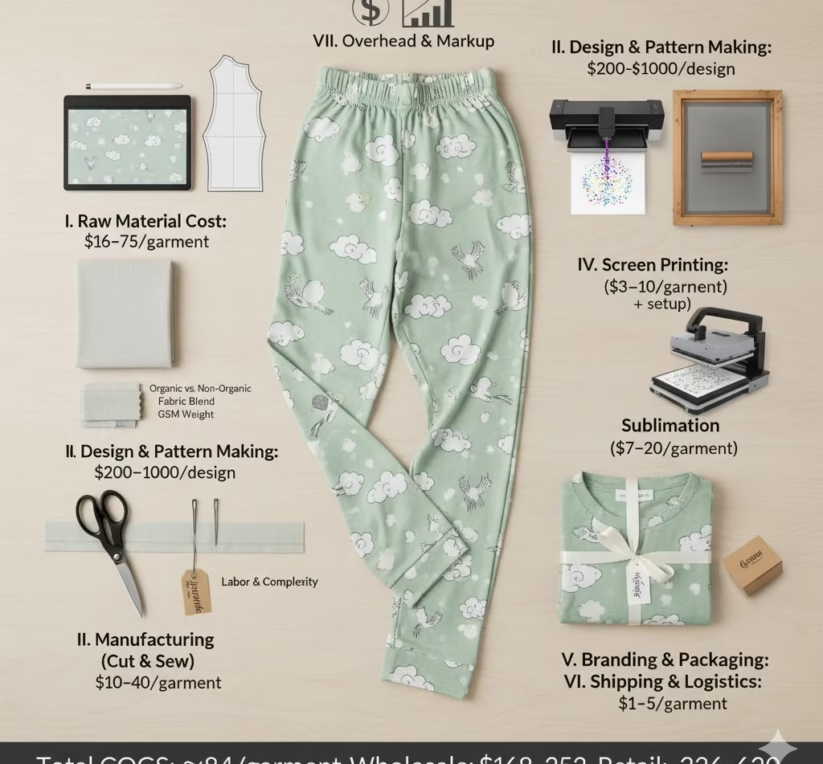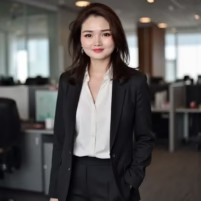Cost Analysis of Custom Printed Bamboo Pajamas
I. The True Cost Formula: Landed Cost
Inhalt
The core of the article must introduce the “Landed Cost” formula, which is the only way to accurately calculate profitability.
II. Tier 1: Herstellung Cost (The Factory Quote)
This is the price per unit quoted by the manufacturer, which is comprised of several key variable factors.
| Cost Component | Key Factors Influencing Price | Typical Range (Per Unit) |
|---|---|---|
| 1. Raw Material (Bamboo Viscose) | Quality/Certification: GOTS certified organic bamboo is typically higher than standard bamboo viscose. | ~$2 – $4 |
| 2. Cut & Sew Labor | Complexity: Zippers, footies, fold-over mittens, and ruffles increase labor hours and cost. | ~$3 – $6 |
| 3. Printing Method (Custom) | Digital vs. Screen Printing: Digital printing is better for low MOQs and complex designs but more expensive per piece. | ~$1 – $3 |
| 4. Minimum Order Quantity (MOQ) | Volume: Higher volume orders (e.g., 1000+ units) significantly lower the per-unit cost. | ~$8 – $15 (Low MOQ) |
| 5. Trims & Accessories | Quality: YKK zippers (premium), custom woven size tags, and branded care labels. | ~$0.50 – $1.50 |
III. Tier 2: Logistics Costs (The Hidden Fees)
These costs are often overlooked by new brands and can destroy margins if not accounted for.
-
Freight: Shipping from the factory (e.g., China, Vietnam) to your warehouse (e.g., USA). The method dictates the cost:
-
Air Freight (Expensive/Fast): Used for samples or rush orders.
-
Sea Freight (Cheap/Slow): Best for bulk production runs.
-
-
Customs Brokerage Fees: Fees paid to a third party to handle the paperwork, duties, and customs clearance.
-
Drayage/Local Delivery: The cost to move the container from the port to your final warehouse or 3PL (Third-Party Logistics) center.
-
Insurance: Protecting your shipment against loss or damage during transit (Incoterms like FOB or CIF determine who pays).
IV. Tier 3: Duties and Taxes
This is one of the most unpredictable areas for apparel, especially bamboo.
-
Tariffs/Import Duties: Calculated based on the product’s HS Code (Harmonized System Code) and the country of origin. Tariffs on certain apparel can be very high (e.g., in the 15-25%+ range).
-
Tariff Calculation Example: If a manufacturer charges 10$ for the pajamas, and the tariff rate is 16%, the duty is 1.60$ per unit.
-
Value Added Tax (VAT) / Goods and Services Tax (GST): Applicable if importing to regions like Europe, Canada, or Australia.
V. Tier 4: Pro-Rated Overhead
These are one-time or fixed costs that must be spread across all units produced.
-
Sampling: The cost of the initial proto-sample, fit sample, and production sample (e.g., 3 x$40 per sample).
-
Pattern Grading: The cost of creating patterns for all sizes (e.g., 0-3M up to 5T).
-
Compliance Testing (CPSIA): Mandatory testing for flammability, lead, and small parts for children’s sleepwear. This is a large, fixed cost (often $500 – $2,000+ per style/fabric/color batch) that must be added to your total Landed Cost.
VI. Conclusion & Profitability Checklist
-
The 3-5x Markup Rule: Once you have your accurate Landed Cost per Unit, you should typically multiply it by a factor of 3 to 5 to arrive at your competitive Retail Price (e.g., Landed Cost of $18 x 4 = $72Retail Price).
-
Profitability Check: Remind the reader that the retail price must cover Landed Cost, Marketing (Ads), and Operational expenses.
Über den Autor
Xhiney, die Gründerin von Petelulu, verfügt über mehr als 20 Jahre Erfahrung in den Bereichen Design, Produktion und internationaler Handel von Kinderbekleidung. Ein Beitrag zu Kinderkleidung und Junior Magazinen hat Xhiney 17 Jahre lang mit hochwertigen Kinderbekleidungsmarken in Europa und den USA zusammengearbeitet und bietet Expertenwissen und Unterstützung.

